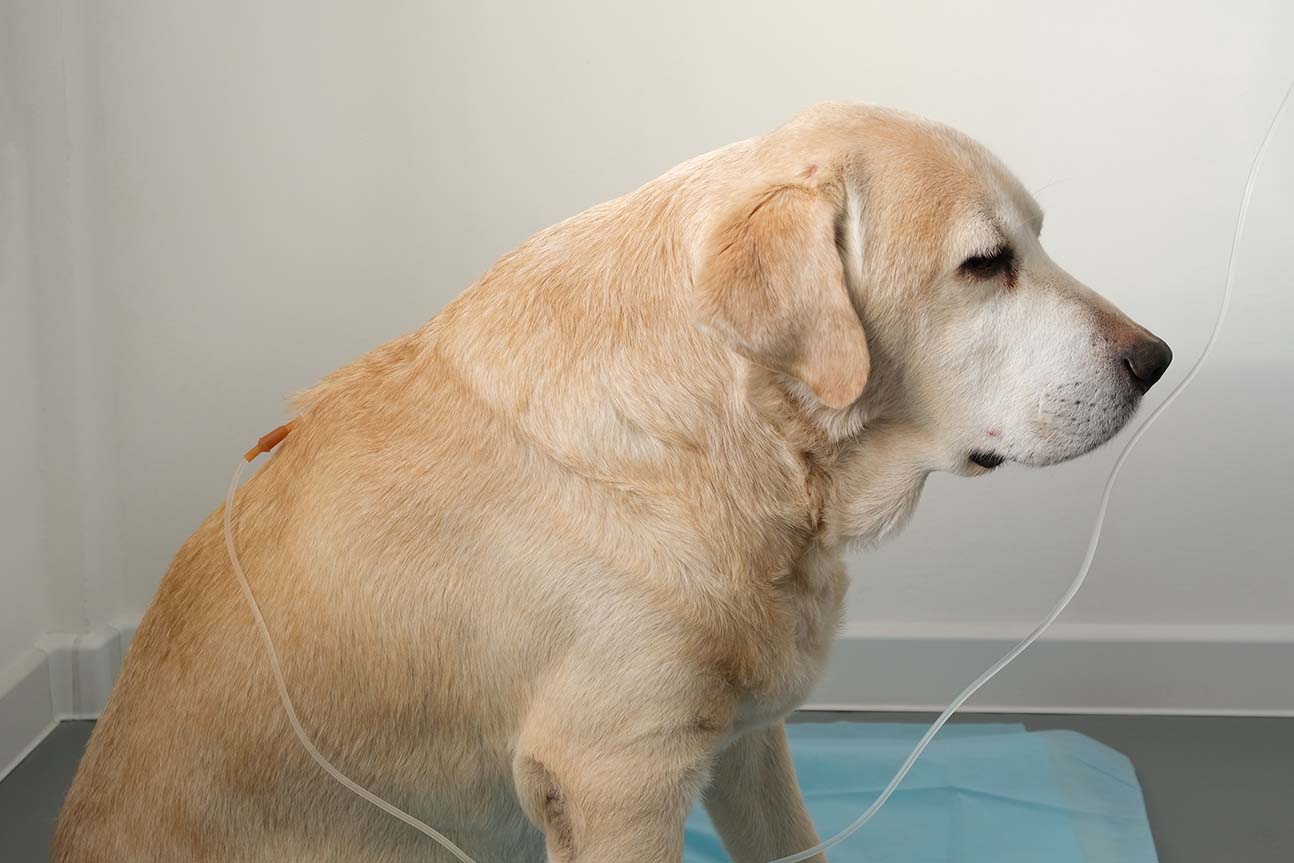Reviewed by Dr. Sarah Yosry
Updated on 23/04/2025
Reading time 4 min.
Overview
Severity: Low
Life stage: All
Kidney failure, or renal failure, is a life-threatening condition that may occur in dogs of any age or breed. Kidneys remove waste products from the bloodstream, keep the body well hydrated, and regulate the balance of vital nutrients. If the kidneys fail, the body accumulates waste products, which create life-threatening complications. Recognizing the symptoms of kidney failure in dogs allows owners to identify the condition early on and get immediate attention by visiting a clinic near me or a vet clinic in Dubai.
Types of Kidney Failure in Dogs
There are two main types of kidney failure in dogs:
Acute Kidney Failure
Acute renal failure comes on abruptly, frequently caused by ingestion of a toxin, infection, lack of water, or extreme trauma. It needs to be treated immediately in a pet hospital to avoid lasting damage.
Chronic Kidney Failure
There is a gradual progression of chronic kidney failure over time, often due to old age or underlying health. Elderly dogs are susceptible to it, and early identification of this condition through regular visits to a vet clinic in Dubai can keep it in check.
Symptoms of Canine Kidney Failure
Excessive Thirst and Urination
Excessive water intake and urination are some of the earliest indications of kidney failure. The kidneys’ capacity for concentrating the urine is diminished, and the pet will be prone to becoming dehydrated and thirsty. If your pet is drinking in excess or experiencing repeated accidents in the house, get a veterinarian near me to examine them.
Loss of Appetite and Weight Loss
Dogs with kidney failure tend to lose their appetite and hence their weight. Nausea due to the accumulation of waste in the circulatory system causes them to reject food. Blood tests by a pet clinic can verify kidney function and suggest dietary changes that benefit the kidney.
Vomiting and Diarrhea
Diarrhea and vomiting are two of the most common digestive conditions in dogs that experience kidney failure. These conditions occur due to toxin buildup in the body that affects the digestive tract. Regular vomiting or diarrhea calls for immediate attention by a veterinary clinic.
Lethargy and Weak
Most dogs with kidney disease tend to feel lethargic and weak as a result of toxin buildup and anemia. If your dog is less active, sleeping excessively, or exhibits fatigue, you may need to consult a vet clinic for test procedures.
Bad Breath and Mouth Ulcers
A dog with kidney failure can develop a characteristic odor of ammonia on the breath due to toxin build-up. Severe cases can also see mouth ulcers develop, which then lead to painful eating for the dog. Regular check-ups in a vet clinic in Dubai can keep these symptoms in check.
Swelling and Fluid Retention
Fluid retention leading to swelling of the legs, paws, or belly in severe kidney failure can be caused by the failure of the kidneys to properly regulate the body’s fluids. If there is unusual swelling, seek a detailed examination from a veterinary clinic in Dubai.
Seizures or Disorientation
With later renal failure, dogs begin to exhibit symptoms of neurologic disease, including loss of coordination confusion, or even seizures. These result when toxin buildup in the bloodstream reaches critical levels. Treatment by a veterinary clinic is needed immediately to deal with such symptoms.
Diagnosis of Kidney Failure in Dogs
Timely diagnosis is critical for successful therapy. These are the most prevalent diagnostic procedures that diagnose kidney failure:
Blood Tests: Most often, a standard blood test is the initial tool that is used to diagnose kidney failure. An increase in waste products like urea (BUN) and creatinine in the bloodstream describes the dysfunction of the kidneys. Creatinine is a very sensitive marker for kidney function. Blood tests also show electrolyte disturbances, which occur in dogs experiencing kidney failure, such as low levels of potassium and elevated levels of phosphorus.
Urinalysis: Urine testing is used to examine how well the kidneys are removing waste. In kidney failure, the specific gravity of the urine will be low, or it will be dilute. Urine may also contain protein or blood if the kidneys are damaged. A urine culture may also be done to test for a urinary tract infection, which is prevalent in dogs with kidney disease.
Imaging methods: Ultrasound and X-rays are crucial in imagining the kidneys and surrounding anatomy. Ultrasounds may be used to identify kidney size changes, cysts, tumors, or obstructions that may be causing kidney dysfunction. X-rays may be used to view the kidney’s appearance and identify any obstruction or other pathologic condition of the urinary system.
Blood Pressure Check: Kidney failure in dogs tends to result in high blood pressure, which may exacerbate kidney damage. Your dog’s blood pressure will probably be checked by your veterinarian to identify if hypertension is a contributing factor to the disease.
Kidney Biopsy: Under rare circumstances, when the etiology of kidney failure is uncertain, a kidney biopsy may be done. A tiny piece of kidney tissue is removed and analyzed by microscope to give insight into the etiology of kidney disease.
Treatment of Canine Kidney Failure
Once diagnosed, the treatments that can be given are based on the severity of kidney failure, acute or chronic, and the dog’s overall health. Treatment may involve:
1. Fluid therapy
Fluid therapy is the mainstay of therapy in kidney failure, particularly in dogs that are dehydrated due to loss of renal function. Fluids given intravenously or subcutaneously are used to replace hydration, maintain electrolyte balance, and remove toxin buildup in the bloodstream. Fluid therapy may stabilize the dog and maintain renal function.
2. Medications
Several medications are utilized to treat symptoms of kidney failure and to correct causes:
• Phosphate binders reduce elevated levels of phosphorus in the bloodstream, which may lead to additional kidney damage.
• Anti-nausea medications prevent vomiting, which is one of the symptoms of renal failure resulting from toxin accumulation.
• Blood pressure drugs are used to manage high blood pressure and guard the kidneys against further strain.
• Antibiotics can be utilized if infections, for example, of the urinary tract are causing kidney problems.
3. Dialysis
In extreme cases, dialysis is used to cleanse the bloodstream of waste products. Hemodialysis or peritoneal dialysis temporarily replaces the function of the kidneys until the dog is stabilized and further treatments can be considered.
4. Dietary Modifications
A special, kidney-safe diet is critical in dogs with renal failure. These diets contain less protein and phosphorus to lessen the strain on the kidneys, yet provide the nutrients needed to keep the animal healthy. Supplements may also be given to ensure electrolyte balance.
5. Kidney Transplant
In dogs with end-stage renal failure, a kidney transplant is a possibility. It is expensive and may or may not be available, however. It involves a compatible donor and close post-transplant surveillance.
6. Palliative Care
In instances where the kidney disease is too far advanced for any treatments that can cure it, palliative care has the goal of providing the dog comfort and enhancing their quality of life. It involves the management of pain, hydration, and ensuring a stress-free environment.
Conclusion
Kidney disease is a critical condition that needs immediate attention and continuous management. Regular follow-ups in a pet clinic, a vet clinic, or a veterinary hospital can diagnose kidney disease early and enhance your dog’s lifestyle. If you happen to be in Dubai, seek the expert care of Modern Vet Hospital equipped with modern diagnostic facilities and tailored treatment plans. Book a visit today to provide your dog with the best medical care it can get.
Share this, choose your platform!
Writen by
Dr.Sarah Yosry
DVM
A product of a rich Australian/Egyptian heritage, Dr. Sarah Yosry stands as a testament to the union of diverse cultures and a shared love for animals.



